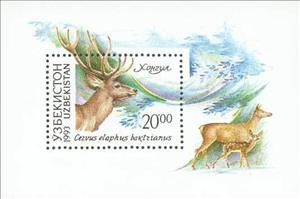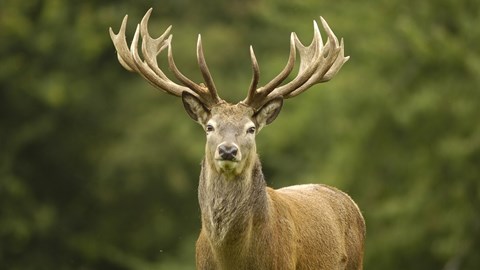Souvenir Sheet: Red deer (Cervus elaphus) (Uzbekistan 1993)
Red deer (Cervus elaphus) (Uzbekistan 1993)
10 March (Uzbekistan ) within release Fauna of Uzbekistan goes into circulation Souvenir Sheet Red deer (Cervus elaphus) face value 20 Uzbekistani som
| Souvenir Sheet Red deer (Cervus elaphus) in catalogues | |
|---|---|
| Michel: | Mi:UZ BL1 |
Souvenir Sheet is horizontal format.
Also in the issue Fauna of Uzbekistan:
- Stamp - Common Wonder Gecko (Teratoscincus scincus) face value 1;
- Stamp - Central Asian Cobra (Naja oxiana) face value 2;
- Stamp - Muskrat (Ondatra zibethica) face value 2;
- Stamp - Osprey (Pandion haliaetus) face value 3;
- Stamp - Eurasian Penduline Tit (Remiz pendulinus) face value 5;
- Stamp - Forest dormouse (Dryomys nitedula) face value 10;
- Stamp - Desert monitor (Varanus griseus) face value 15;
- Souvenir Sheet - Red deer (Cervus elaphus) face value 20;
- Stamp - Red Deer (Cervus elaphus) face value 20;
Souvenir Sheet Red deer (Cervus elaphus) it reflects the thematic directions:
Mammals are any vertebrates within the class Mammalia (/məˈmeɪli.ə/ from Latin mamma "breast"), a clade of endothermic amniotes distinguished from reptiles (including birds) by the possession of a neocortex (a region of the brain), hair, three middle ear bones and mammary glands. All female mammals nurse their young with milk, secreted from the mammary glands. Mammals include the largest animals on the planet, the great whales. The basic body type is a terrestrial quadruped, but some mammals are adapted for life at sea, in the air, in trees, underground or on two legs. The largest group of mammals, the placentals, have a placenta, which enables the feeding of the fetus during gestation. Mammals range in size from the 30–40 mm (1.2–1.6 in) bumblebee bat to the 30-meter (98 ft) blue whale. With the exception of the five species of monotreme (egg-laying mammals), all modern mammals give birth to live young. Most mammals, including the six most species-rich orders, belong to the placental group. The largest orders are the rodents, bats and Soricomorpha (shrews and allies). The next three biggest orders, depending on the biological classification scheme used, are the Primates (apes and monkeys), the Cetartiodactyla (whales and even-toed ungulates), and the Carnivora (cats, dogs, seals, and allies).
A deer (pl.: deer) or true deer is a hoofed ruminant ungulate of the family Cervidae. It is divided into subfamilies Cervinae (which includes, among others, muntjac, elk (wapiti), red deer, and fallow deer) and Capreolinae (which includes, among others reindeer (caribou), white-tailed deer, roe deer, and moose). Male deer of almost all species (except the water deer), as well as female reindeer, grow and shed new antlers each year. These antlers are bony extensions of the skull and are often used for combat between males.


